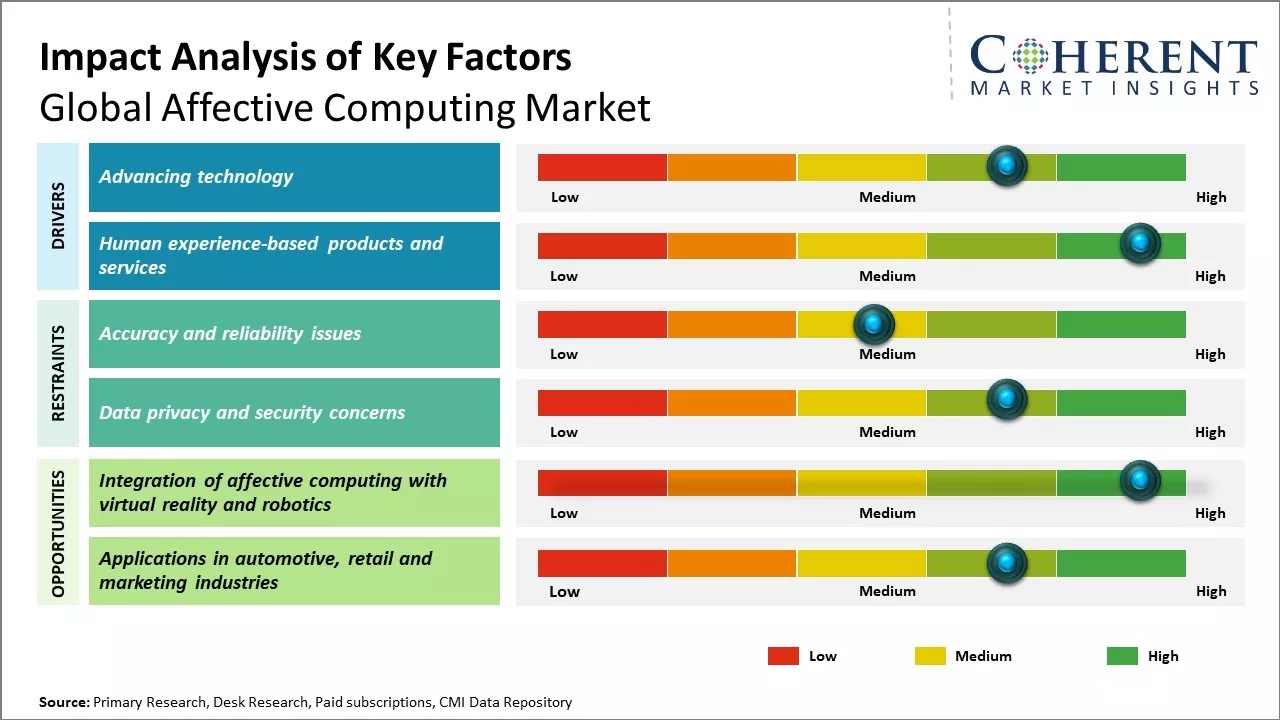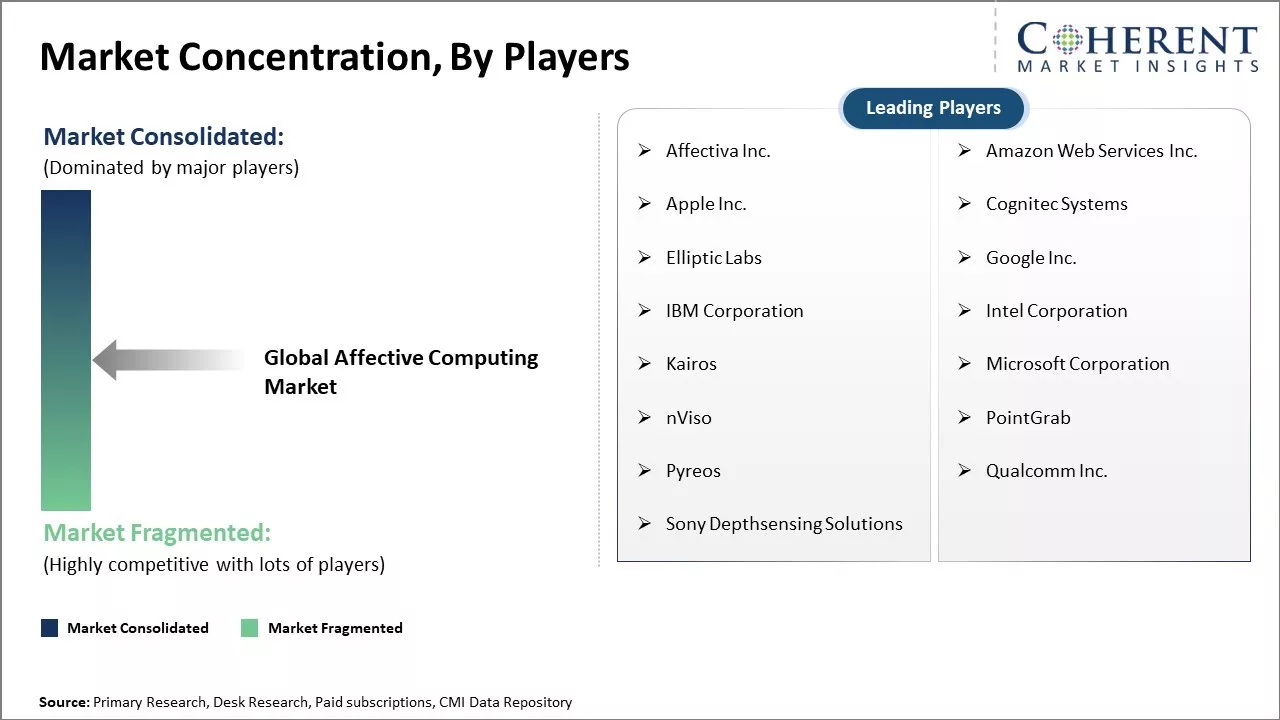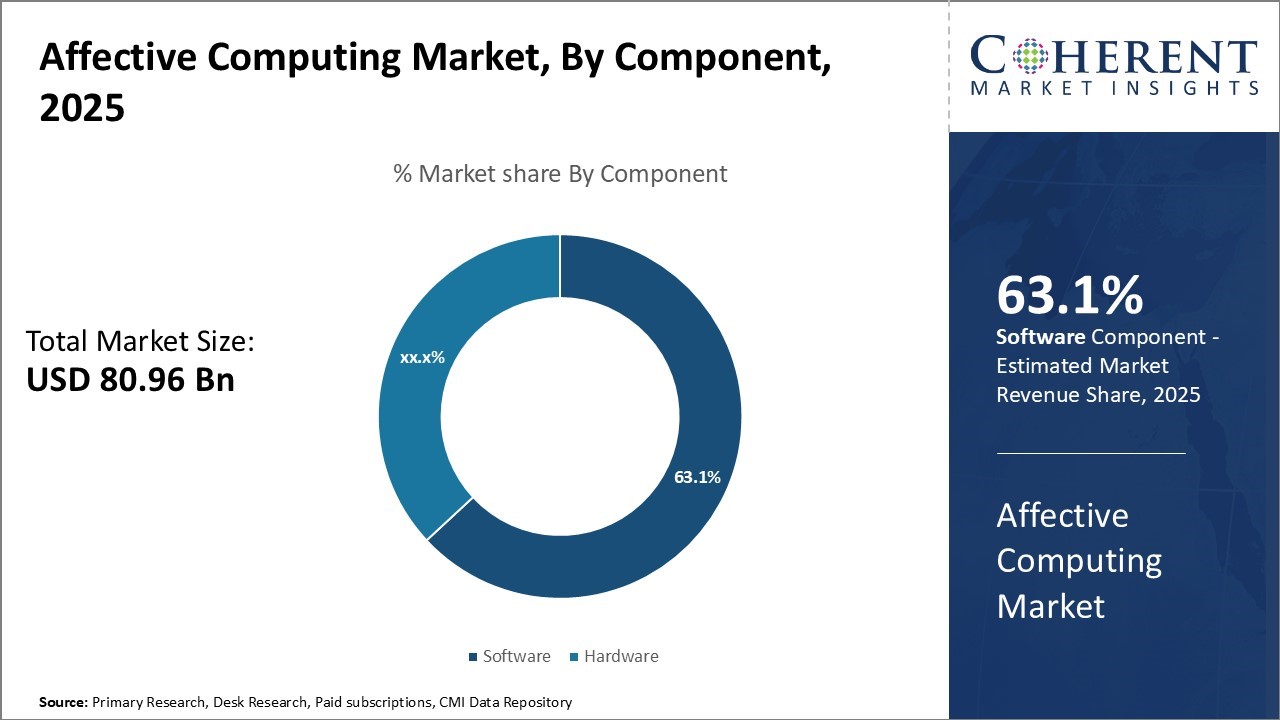The Global Affective Computing Market size is estimated to be valued at USD 80.96 Bn in 2025 and is expected to reach USD 375.56 Bn by 2032, exhibiting a compound annual growth rate (CAGR) of 24.5% from 2025 to 2032.

To learn more about this report, Download Free Sample
The Global Affective Computing Market growth can be attributed to rising demand for advanced conversational artificial intelligence and increased focus on integrating human emotions with machines. Growing need for contactless biometrics and ambient computing experience across industries is further expected to fuel the market expansion. Adoption of affective technology solutions is increasing across various verticals such as BFSI, healthcare, government & defense, IT & telecom, and retail among others due to their ability to offer personalized customer experience and optimize operational efficiencies through emotional data analytics. Integration of affective computing with augmented reality and virtual reality is also anticipated to create new business opportunities for market players. However, complex design and high costs associated with affective computing systems may hamper the market growth.
|
Event |
Description and Impact |
|
EU Artificial Intelligence Act Implementation (2025) |
|
|
Semiconductor Supply Chain Developments |
|
|
Healthcare Sector Breakthroughs |
|
Uncover macros and micros vetted on 75+ parameters: Get instant access to report
The affective computing market features diverse pricing across software, hardware, and industry-specific solutions driven by AI and IoT advances.
Software pricing ranges from $5,000–$20,000/year for basic SDKs to $50,000–$500,000+ for enterprise multimodal platforms. Cloud APIs charge $0.02–$0.50 per emotion analysis call. Biometric sensors cost between $150 and $5,000 depending on type and sophistication.
Industry solutions vary: healthcare patient monitoring systems cost $10,000–$50,000 per bed; mental health platforms charge $30–$150/user/month. Retail analytics range from $2,000 to $10,000 per location monthly, with CRM integrations up to $250,000 annually. Automotive driver monitoring costs $200–$800 per vehicle.
Enterprise contracts show pricing tiers: healthcare from $50K entry to $2M+ enterprise; retail $20K to $1M+; education $10K to $500K+.
Regionally, North America commands a 20-35% premium, Europe adds 15-25% GDPR surcharges, and Asia-Pacific solutions are 40-60% cheaper. Emerging trends include performance-based pricing, Emotion-as-a-Service models, and growing open-source adoption.
ROI for large investments typically spans 18-24 months, reflecting growing market maturity and integration complexity.
Affective computing is rapidly advancing by bridging human emotions with machine intelligence to enable more intuitive and empathetic interactions. Key technological trends include the integration of emotion recognition into everyday devices such as smartphones, wearables, automotive systems, and virtual assistants. This progress is powered by improvements in machine learning, computer vision, and natural language processing, allowing real-time analysis of facial expressions, voice tone, and context.
Beyond recognition, emerging innovations focus on simulating emotions in machines, with virtual agents and emotionally adaptive chatbots enhancing personalization. Emotionally intelligent robots are also gaining traction in healthcare, education, and customer service.
The use of biometric sensors—like heart rate monitors, skin conductance, and eye-tracking—adds deeper physiological insights for accurate emotion detection, particularly benefiting healthcare applications by enabling real-time monitoring of emotional well-being.
Industry adoption is accelerating with new product launches embedding affective computing into automotive safety systems, immersive gaming, and virtual reality experiences. These technologies improve emotion recognition accuracy and foster adaptive, user-friendly interfaces across sectors.
While offering vast opportunities for personalized consumer insights and engagement, affective computing faces challenges around data privacy, algorithmic bias, and ethical use. Responsible development and regulation will be critical to unlocking its full transformative potential.

To learn more about this report, Download Free Sample
One of the major drivers for the growth of the global affective computing market forecast is the rapid advancement in various technologies such as artificial intelligence, cloud computing, sensor technologies, and neuroscience. The development of artificial intelligence and machine learning technologies has enabled companies to create solutions capable of deciphering human emotions and feelings. New sophisticated technology is being developed that recognizes different types of faces, body language, and voice tones, and understands the feelings associated with conversations. This assist machines and computers to interpret human emotions.
At the same time, the wide-spread use of cloud computing is enabling the creation of advanced affective computing solutions. Emotion recognition software and affiliated technologies can be improved based on the vast data available on cloud. The results obtained from deep learning and the tests performed on recognition of emotions can be stored in the cloud and analyzed to be further improved. This is quite helpful to technology companies to create more advanced and human-friendly affective computing tools. Furthermore, there is a rapid development in the miniaturization of a variety of sensors such as cameras, microphones, EEG sensors, etc. which enables their integration into different devices and equipment. Advanced sensors that capture subtle human actions, changes, and physiological signals are now being embedded in wearables, smartphones, and computers which aid in emotion detection.
With user experience emerging as a pivotal factor for brand differentiation, leading technology firms and institutions are adopting affective computing to deepen their understanding of user engagement with devices and services. Considerable attention is being paid to the development of solutions, devices, platforms, and applications that can automatically detect human emotions and adapt to provide more personalized and insightful interactions.
To illustrate, virtual assistants are being programmed to interpret the emotional context behind questions to respond with appropriate empathy. Similarly, voice assistants are enhancing their perception by adding tonality analysis to gauge user sentiment for adjusting responses. Customer service chatbots are also using affective computing to assess customer anger and escalate calls automatically to human operators when necessary. Beyond consumer technology, however, many sectors are understanding the relevance of affective computing for augmenting user and client interaction engagement.
One of the major challenges restraining the growth of affective computing market is issues related to accuracy and reliability of emotional recognition. Affective computing aims to recognize, interpret, process, and simulate human affects. However, existing technology has limitations in accurately recognizing human emotions through facial expressions, speech, text, physiological signals, etc. This is because human emotion is highly complex and influenced by various internal and external factors. What an AI system interprets as anger could be frustration or annoyance for humans.
Similarly, sadness could be due to temporary mood swings rather than a clinical condition. Inaccurate emotion detection can have negative consequences in several applications of affective computing like education, workplace monitoring, healthcare, and customer service. It can also severely impact user experience and trust in the technology.
The lack of labeled data for more granular and diverse human emotions is another factor contributing to accuracy issues. Most available databases only have labels for basic emotions like happy, sad, angry, fear, etc. They do not account for subtle variations and combinations of emotions experienced by humans on a daily basis. This limited labeled data restricts the ability of machine learning algorithms to truly understand complex human affects.
Integration of affective computing with virtual reality and robotics holds huge potential to drive growth in the global affective computing market in the coming years. Integrating this ability with technologies like VR and robotics can help build profoundly empathetic systems.
VR immerses users in simulated environments and allows for realistic social interactions and experiences. Coupling this with affective computing can enhance user experience tremendously. VR systems equipped with affective abilities may be able to understand users' emotional state and fine-tune the experience accordingly.
For example, a VR simulation meant for trauma therapy could detect if a user is getting distressed or anxious and automatically dial down frightening elements to alleviate their distress. On the other hand, an edutainment VR game may be able to sense enjoyment and raise the challenge level dynamically to maintain user engagement.
Affective computing also has the promise to revolutionize human-robot interactions. Robots integrated with affective skills may be able to understand human emotions, respond compassionately to emotional cues like tone of voice, and adapt their behavior to be more helpful, harmless and honest.
For example, socially assistive robots able to perceive stress or frustration in elderly users' speech may know to slow down instructions or offer emotional comfort. Researchers are also exploring how robots' own facial expressions and movements can be designed to appear warm, harmless and transparent based on human affect recognition feedback.

To learn more about this report, Download Free Sample
The software segment is projected to capture the largest share of the affective computing market demand in 2025, with an expected contribution of 63.1%. This expansion stems from the impact that complex software systems have on enabling various affective solutions throughout industries. In particular, software systems that are user-friendly and powerful are more sought after as developments in affective computing progress. These platforms enable organizations to utilize artificial emotions and advanced systems to create customized interactions between humans and computers.
For instance, advanced algorithms and programming can enable devices to analyze speech patterns for anxiety and modify responses accordingly, adjusting in real time. To enhance affective capabilities, continuous updates to software are crucial. Companies integrate new data processing techniques to strengthen the functionalities of emotional intelligence in their products, making it easier to retain competitive positions in rapidly changing markets. The flexible nature of software also allows easy incorporation of new hardware that comes with advancements in technological interfaces. As the use of affective technologies grows across different domains, there will be sustained strong demand for innovative software solutions.
The touch-based segment is anticipated to dominate the affective computing market value in 2025, capturing an impressive 56.6% share. This dominance stems from the intuitive nature of touch interfaces, which have become the primary mode of interaction with technology through devices such as smartphones, tablets, and laptops.
Touch-based affective systems are designed to detect subtle variations in user interactions, including touch patterns, pressure levels, and gestures, enabling them to interpret emotions and customize responses accordingly. Applications include interactive museum displays that gauge visitor engagement through touch and adaptive games that respond to stress levels indicated by grip pressure.
The widespread use of touchscreens has facilitated extensive research into affective algorithms, allowing for accurate emotion analysis even with limited datasets. Unlike other modalities that may require specialized hardware or are influenced by environmental factors, touch-based technologies provide a more straightforward and user-friendly approach. As reliance on touch interfaces continues to grow, the affective computing market is poised to leverage this technology to create advanced and accessible emotional solutions.
The healthcare sector is projected to account for the largest share of the affective computing market trend in 2025, with an estimated contribution of 46.2%. This growth is attributed to the significant advantages that affective computing offers, such as enhanced emotional detection and analysis, which can lead to improved patient care and provider support.
In healthcare, technologies that can detect and interpret emotional states are increasingly being integrated into patient management systems. For example, affective robots can monitor elderly patients for signs of isolation or mood changes that may indicate health issues. Similarly, virtual assistants equipped with affective computing capabilities can recognize stress levels in healthcare providers and suggest timely interventions, such as relaxation techniques.
Moreover, the ability to analyze large datasets from wearable devices and medical IoT technologies allows for a deeper understanding of the relationship between emotional states and health conditions. This could facilitate breakthroughs in personalized prevention and treatment strategies. As the healthcare industry faces challenges like aging populations and workforce shortages, the adoption of affective computing technologies is becoming essential for enhancing access to care, improving health outcomes, and ensuring quality of life for patients.

To learn more about this report, Download Free Sample
North America is projected to lead the global affective computing market with a 38.7% share in 2025, largely fueled by substantial R&D investments from prominent U.S.-based technology giants such as Microsoft, IBM, and Amazon. North America is at the forefront of the adoption of affective computing technologies due to the strong consumer electronics market and growing need for specialized applications in the healthcare, education, and marketing sectors. Additionally, the government’s funding for research and programs supporting new businesses has reinforced North America’s lead position. The U.S. remains a leader in this market because of ongoing innovation and collaborations, even with other regions experiencing rapid growth.
Asia Pacific, with China at the forefront, is recognized as the fastest growing region in the affective computing market in 2025. Aggressive investments by major Chinese tech companies like Baidu, Alibaba, and Tencent are driving development of AI-powered emotion recognition solutions tailored to local market needs.
The region benefits from a vast population, an expanding middle class, and strong government policies supporting future technology development. These factors collectively enable wide-scale deployment of affective computing products across e-commerce, education, entertainment, and smart city projects. The region’s skilled workforce and rising exports further contribute to its rapid market expansion.
Europe’s affective computing market growth is primarily driven by expanding applications in personal healthcare and evolving virtual assistant technologies. Leading technology firms such as SAP and Anthropic, headquartered in Germany and the U.K., are spearheading innovation, while regional startups explore opportunities in cybersecurity, automotive, and defense sectors.
However, market fragmentation and relatively lower R&D expenditure pose challenges to matching the innovation pace seen in North America and Asia Pacific. Nevertheless, demand from multinational corporations operating in the region sustains Europe’s notable market share and development trajectory.
The U.S. commands the North American affective computing market, supported by a mature technology ecosystem and substantial investments in AI research. The country’s leadership in consumer electronics and enterprise AI solutions fosters ongoing innovation in emotion recognition platforms. Government initiatives and collaborations with academic institutions further strengthen the market, despite challenges such as data privacy regulations influencing technology deployment.
China stands out as a key driver within Asia Pacific’s affective computing segment, propelled by leading tech firms investing heavily in localized AI applications. A large domestic market, combined with favorable government policies and a growing talent pool, enables rapid commercialization and adoption across diverse sectors including smart retail, education, and urban development. The country’s export potential and strategic focus on future technologies position it as a critical player in the global affective computing landscape.
| Report Coverage | Details | ||
|---|---|---|---|
| Base Year: | 2024 | Market Size in 2025: | USD 80.96 Bn |
| Historical Data for: | 2020 To 2024 | Forecast Period: | 2025 To 2032 |
| Forecast Period 2025 to 2032 CAGR: | 24.5% | 2032 Value Projection: | USD 375.56 Bn |
| Geographies covered: |
|
||
| Segments covered: |
|
||
| Companies covered: |
Affectiva Inc., Amazon Web Services Inc., Apple Inc., Cognitec Systems, Elliptic Labs, Google Inc., IBM Corporation, Intel Corporation, Kairos, Microsoft Corporation, nViso, PointGrab, Pyreos, Qualcomm Inc., and Sony Depthsensing Solutions |
||
| Growth Drivers: |
|
||
| Restraints & Challenges: |
|
||
Uncover macros and micros vetted on 75+ parameters: Get instant access to report
*Definition: The Global Affective Computing Market consists of companies developing technologies that can interpret human emotions and sentiments. These technologies utilize techniques from psychology, computer science, and neuroscience to recognize, process, and replicate human affects such as emotions, moods, and feelings. Affective computing analyzes human facial expressions, speech, gestures, physiological measures, and other behaviors to evaluate personal psychological states and trait attributes. It has applications in domains such as marketing, health care, education, and human-computer interaction design.
Share
Share
About Author
Monica Shevgan has 9+ years of experience in market research and business consulting driving client-centric product delivery of the Information and Communication Technology (ICT) team, enhancing client experiences, and shaping business strategy for optimal outcomes. Passionate about client success.
Missing comfort of reading report in your local language? Find your preferred language :
Transform your Strategy with Exclusive Trending Reports :
Frequently Asked Questions
Joining thousands of companies around the world committed to making the Excellent Business Solutions.
View All Our Clients